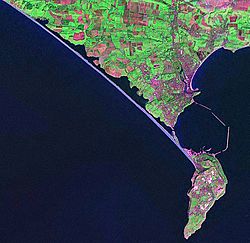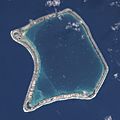Lagoon facts for kids
A lagoon is a body of salt water that is partly separated from the open sea. Think of it like a calm, shallow pool next to a big ocean. A natural barrier usually protects and separates the lagoon from the rough waves of the sea. This barrier can be a pile of pebbles or shingle beach (small, smooth stones), a sand bank, or even a coral reef that surrounds an atoll. An atoll is a ring-shaped island made of coral, often formed around a sunken volcano.
The word "lagoon" is used for two main types: coastal lagoons, which are found along coastlines, and the lagoons inside atolls. Atoll lagoons form when coral reefs grow around oceanic islands that are slowly wearing away due to erosion.
Contents
What is a Lagoon?
A lagoon is a shallow area of water that is connected to the sea but also partly closed off. This means its water is usually salty, just like the ocean. The main feature of a lagoon is the natural barrier that protects it. This barrier acts like a wall, keeping the lagoon calm and separate from the open sea.
How Lagoons Form
Lagoons can form in different ways, depending on where they are located.
- Coastal Lagoons: These form along coastlines. They are often created when sandbars, barrier islands, or shingle beaches build up over time, separating a part of the sea from the main ocean. The water in these lagoons can be a mix of fresh water from rivers and salty sea water.
- Atoll Lagoons: These are found in the middle of oceans. They form when coral reefs grow upwards around a volcanic island. Over millions of years, the volcano might sink or erode away, leaving behind a ring of coral with a calm lagoon in the center.
Types of Barriers
The barriers that create lagoons can be made of different materials:
- Sand Banks and Barrier Islands: These are long, narrow piles of sand that form offshore, parallel to the coastline. They protect the water behind them, creating a lagoon.
- Pebble or Shingle Beaches: These are beaches made of small stones. Sometimes, these beaches can grow large enough to enclose a body of water, forming a lagoon. A famous example is Chesil Beach in England.
- Coral Reefs: In tropical areas, coral reefs can grow into a ring shape, forming an atoll. The calm water inside this coral ring is an atoll lagoon.
Examples of Lagoons
Many lagoons exist around the world, each with its own unique features.
- Chesil Beach in England has the Fleet lagoon behind it. This is a coastal lagoon protected by a long shingle beach.
- Blaketown Lagoon in New Zealand is another coastal lagoon that stays connected to the sea.
- Fangataufa is an atoll in the Pacific Ocean. Its lagoon is quite large, about 5 kilometers by 8 kilometers. The whole atoll is about 9.5 kilometers by 9.5 kilometers.
- Kara-Bogas-Gol in Turkmenistan is a very large lagoon, almost like an inland sea, connected to the Caspian Sea.
-
Chesil Beach, the Fleet lagoon, and the Isle of Portland, seen from the north-west over Abbotsbury.
-
Blaketown Lagoon, New Zealand. It is connected to the sea.
-
Fangataufa is an atoll in the Pacific Ocean. Its lagoon is about 5km by 8 km.
-
Kara-Bogas-Gol in Turkmenistan.
Images for kids
-
Balos coastal lagoon in northwestern Crete. This shallow lagoon is separated from the Mediterranean Sea by narrow sandbars connected to a small, rocky mountain.
-
Garabogaz-Göl lagoon in Turkmenistan.
-
A satellite picture of the Atafu atoll in Tokelau in the Pacific Ocean.
-
Anzali Lagoon on the southwestern Caspian Sea coast, Iran.
-
A photo of Mar Menor as seen from the International Space Station.
See also
 In Spanish: Laguna costera para niños
In Spanish: Laguna costera para niños











